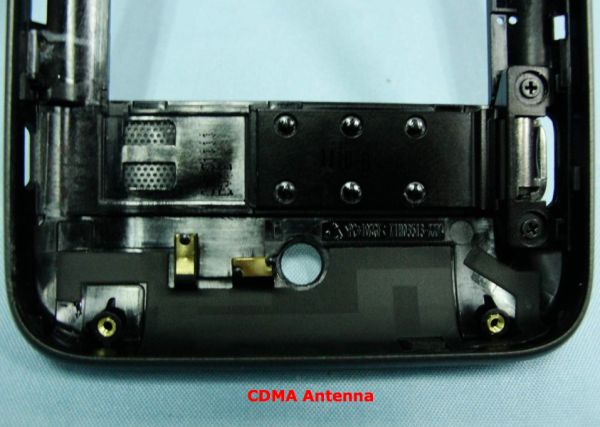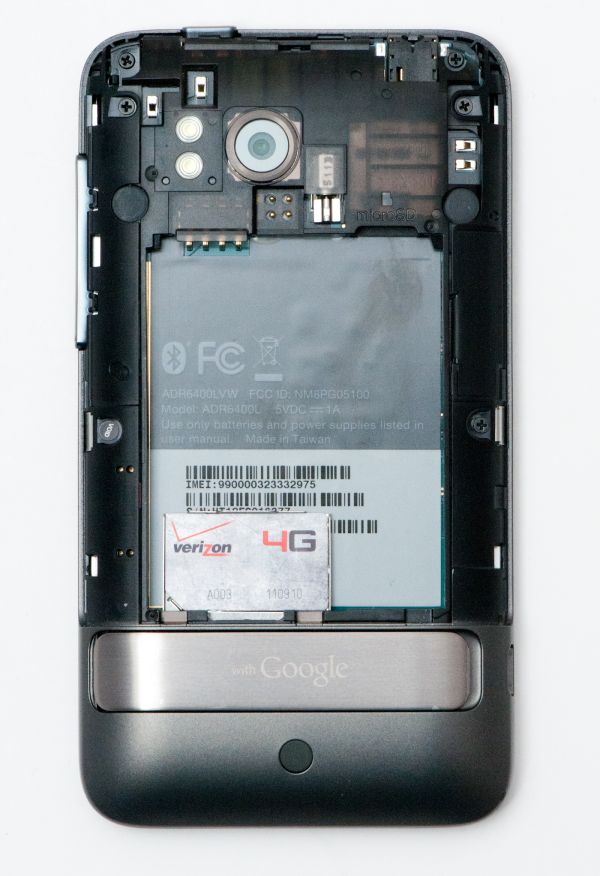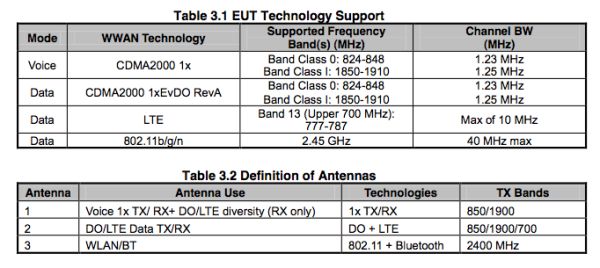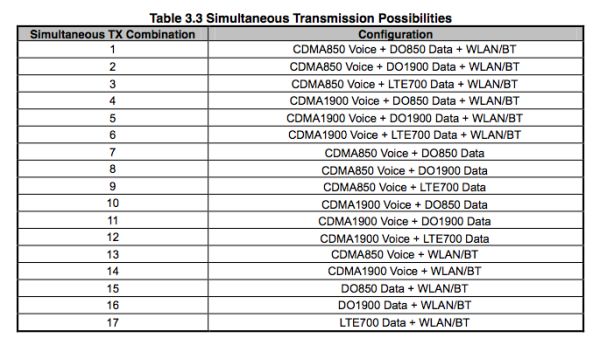HTC Thunderbolt Review: The First Verizon 4G LTE Smartphone
by Brian Klug on April 27, 2011 12:12 AM EST- Posted in
- Smartphones
- HTC
- Verizon
- LTE
- 4G
- Android
- HTC Thunderbolt
- Mobile
- MDM9600
- MSM8655
A Tale of Two Cellular Radios
I suppose now is as good a time as any to delve into the dual transceiver situation on the Thunderbolt. The two transceivers I speak of are the MSM8655’s built in cellular baseband (like all Qualcomm SoCs, you get a modem for free), and the MDM9600 which sits at the heart of every single other Verizon LTE product except the LG VL600 data card, which uses LG’s own L2000 chipset. If you want the short story, the Thunderbolt fully supports simultaneous CDMA2000-1x voice and 3G EVDO or 4G LTE data. The way this is done should already be somewhat obvious - the MSM8655 gives the Thunderbolt a continual free CDMA 1x connection for voice, SMS, and slow data, and the MDM9600 does all the 3G EVDO and 4G LTE data heavy lifting. What this boils down to is real SVDO (Simultaneous Voice Data Optimized) and SVLTE (Simultaneous Voice and Long Term Evolution data).

You can see proof of this in the Thunderbolt’s EPST menus, where there’s a second additional field marked “9k” which clearly is for the MDM9600 (9600, 9k, ahh right).
This situation also starts to become clear when you pry the battery cover off the back of the phone. Getting the battery cover off is incredibly difficult the first time. I swear I almost broke the thing the first time I did it. There are seriously more than ten plastic clips and guides which hold the door securely in position.
The Thunderbolt comes by default with a 1400 mAh, 3.7 VDC (5.18 Whr) battery (the official extended battery is 2750 mAh, 3.7 VDC, 10.18 Whr, as an aside). If you remove the battery, you can access the Thunderbolt’s USIM which slides out long ways first in a metal carrier. This is the first time I’ve seen a SIM door insert this way, but it works.
While we're talking about SIMs, Verizon's is technically both a CSIM and USIM. CDMA credentials are on the SIM (CSIM) as well as the credentials for LTE (USIM). The way the term SIM is abused lately for anything resembling one will likely continue, but if you're going to be pedantic, it's really both. Anyhow, as a result, you can finally swap devices on Verizon without having to call support, give them an ESN, and wait for routing tables to switch everything over. I haven't personally tried it since I don't have two Thunderbolts, but Verizon does advertise this is as a notable feature that finally brings full device portability. This is a huge feature if you intend to swap between devices a lot.
The reason why it’s held on so securely makes sense the second you get it off - there are two antennas back here built into the door. The reason for such a stiff and beefy door is so that no fewer than four independent contacts need to be held in good electrical contact. Count them - two contacts for the top right connector, another for top left, and another for wireless induction charging if you go with the extended battery combo.
Though we never reviewed it formally, the myTouch 4G was the first time I saw HTC start to go down the modular antenna route, with a similarly detachable (internal) antenna board. The Thunderbolt does the same thing here, yet builds it into the battery door. Likewise, the HTC Desire HD does the same thing, as does the upcoming Sensation. It isn’t just Apple that gets creative with antennas now and then, HTC deserves some credit too.
The antenna on the left is for GPS and even bears a marking to that effect on the flex board. The one on the right is for the MDM9600 and thus works for data on LTE and EVDO. There are two holes which punch clean through to the opposite side, clearly to ensure good contact with whatever antenna is built into this battery door.
There are two more antennas on the Thunderbolt, bringing the grand total to four. There’s one in the flex style we’re used to seeing which curves around the back and is for WiFi and BT, and another at the bottom right where we’re used to seeing them for CDMA 1x.
 CDMA 1x Antenna at the bottom, Source: FCC
CDMA 1x Antenna at the bottom, Source: FCC
That’s a bit of a simplification too. If you’ve read anything about LTE or our other piece on it, you should know by now that a large part of the specification is mandatory multiple antenna support. At least on Verizon’s LTE network all devices need to be category 2 or 3, which means they must incorporate MIMO. The HTC Thunderbolt’s UL MIMO configuration is 1x2, meaning it has 1 transmit antenna and 2 receive antennas. The RF chains for both the MSM8655 and MDM9600 basebands are independent, however the two share an Rx antenna at the bottom in the traditional spot. This antenna serves as 1x voice Tx/Rx for the MSM8655, and EVDO/LTE Rx for the MDM9600.
The one at the top is EVDO/LTE Tx/Rx for the MDM9600. You can verify this yourself if you pry the back cover off the phone while in an LTE or EVDO data session - it goes away and you promptly fall back to slow 1x data. Pretty cool though.
I spent a lot of time on the phone with Qualcomm talking about the radios in the Thunderbolt and LTE in general. I ended up learning a ton more about the number of design challenges involved with making SVDO and SVLTE work for the first time and gained an appreciation for even more complexities than I expected.
First off, since this is the first phone (I’m aware of) with dual cellular transceivers that can be active at the same time, Qualcomm and HTC had to work with the FCC to establish proper testing to making sure the Thunderbolt meets FCC SAR (Specific Absorption Rate) requirements. Remember that although the HTC EVO 4G could have conceivably supported simultaneous 4G WiMAX and 1x voice, the feature was disabled and to my knowledge hasn’t ever been enabled. It’s for this reason - until the Thunderbolt no proper procedure for characterizing dual transceiver phones existed. (Update: Apparently the EVO does support simultaneous WiMAX data and 1x voice, thanks everyone!)
Architecting a dual-transciever cellular system that works properly with FCC SAR requirements necessitated some communication and logic between the MDM9600 and MSM8655 basebands. This is noted in addition in the FCC report for the Thunderbolt:
Although the RF circuits are independent for both transmitters, the chipset solution incorporated SVDO/SVLTE implementation does include electrical connections between the voice and data transmitters such that the device can coordinate the transmit power of both transmitters. That said, the transmitters operate independently in the sense that they independently support voice or data connection without interaction between the modems or signaling from the WWAN network.
It’s an edge case, but imagine a situation where you’re at cell’s edge transacting both LTE data and 1x voice. In that circumstance, SAR could theoretically exceed legal limits. To keep this from happening, that communication link between the MDM9600 and MSM8655 lets the Thunderbolt know the power and link budgets for both and allocate accordingly by reducing throughput on the data link. There are a whopping 17 Tx configurations that the Thunderbolt needs to support all while maintaining legal power budgets.
I tested endlessly trying to detect any 4G LTE speed degradation at the cell edge while on a voice call but never could notice anything appreciable.
This wouldn't be a complete review without a measurement to show whether the Thunderbolt is prone to deathgrip. Luckily thanks to the antenna diversity we've outlined, the Thunderbolt really isn't. I've done the due diligence of measuring the handset in our usual positions in both 3G and 4G environments.
| Signal Attenuation Comparison in dB - Lower is Better | ||||||||
| Cupping Tightly | Holding Naturally | Holding in Case | On an Open Palm | |||||
| HTC Thunderbolt - LTE | 5.3 | 2.5 | - | 4.4 | ||||
| HTC Thunderbolt - EVDO | 6.5 | 0.8 | - | 7.2 | ||||
| Verizon iPhone 4 | 16.5 | 15.5 | 9.0 | 7.9 | ||||
| LG Optimus 2X | 13.7 | 9.3 | - | 5.9 | ||||
| Nexus S | 13.3 | 6.1 | - | 4.3 | ||||
| Droid 2 | 11.5 | 5.1 | - | 4.5 | ||||
| BlackBerry Torch | 15.9 | 7.1 | - | 3.7 | ||||
| Dell Streak | 14.0 | 8.7 | - | 4.0 | ||||
| Droid X | 15.0 | 5.1 | - | 4.5 | ||||
| AT&T iPhone 4 | 24.6 | 19.8 | 7.2 | 9.2 | ||||
| iPhone 3GS | 14.3 | 1.9 | 3.2 | 0.2 | ||||
| HTC Nexus One | 17.7 | 10.7 | 7.7 | 6.7 | ||||
The Thunderbolt has noticeably less attenuation when held in a 4G LTE scenario, no doubt thanks in part to the fact that it's fully leveraging MIMO and also on a 700 MHz carrier. I was surprised to see that make any measurable difference. I also saw a considerable amount of variance before the number settled down, which to me definitely indicates some DSP deciding on what link it can reliably hang onto in LTE coverage. In 3G EVDO the picture isn't as complicated, again attenuation is low until you put flesh over both antennas like what happens when it's on an open palm.
















71 Comments
View All Comments
cmdrdredd - Thursday, April 28, 2011 - link
Or if you're stuck on an old android phone that has no memory, hardly any cpu or gpu power, and bogs down heavily all the time thanks to the new OS revisions not being highly optimized for slower phones (no upgrade path even for some too), and you decided you don't want to be a slave to Apple and what they decide you can and cannot have/do with the device, you might look at this for your upgrade if you were itching right now. Why wait for June to see the new Droid Bionic when you need a phone now that works properly and is faster?deputc26 - Wednesday, April 27, 2011 - link
Now THIS is a smartphone review. This is the meticulous quantitative data that I keep coming back to Anandtech for. Would like to see real world load times of real web sites though.7Enigma - Wednesday, April 27, 2011 - link
Seconded. I'm not a huge fan of smartphones (I don't own one and normally just skim the reviews for hardware/OS information) but this one reminded me of old-school Anandtech. Nitty-gritty detail and substance that anyone can tell required a LONG time to write.And factoring in the legitimate excuse of being ill made it all the more impressive.
Great job again Brian.
kurt-o - Wednesday, April 27, 2011 - link
The article stated "Remember that although the HTC EVO 4G could have conceivably supported simultaneous 4G WiMAX and 1x voice, the feature was disabled and to my knowledge hasn’t ever been enabled. It’s for this reason - until the Thunderbolt no proper procedure for characterizing dual transceiver phones existed."Unless I'm confused here, the article appears to have a blatant error. The HTC EVO 4G supports simultaneous 4G WiMAX and 1x-Voice. Has since day 1.
metafor - Wednesday, April 27, 2011 - link
I think what's meant is that it can't do simultaneous voice and data over 3G, which is true. If you are in a 4G area, I believe the Evo can use WiMax for data and 3G for voice.Brian Klug - Wednesday, April 27, 2011 - link
Are you certain? Although I have an EVO I'm not in a WiMAX market, so I can't test for certain. I know that WiFi + 1x voice is a definite go, 1x voice + EVDO is a no, but I was under the impression again that 1x voice + WiMAX is also a no.From the user manual:
"Can I make calls and use data services at the same time?
You cannot use voice and data services simultaneously. If you receive a call while data service is active, your device forwards the call to voicemail. You can place an outgoing call anytime, but it will interrupt any in-progress data session."
-Brian
privater - Wednesday, April 27, 2011 - link
Does this phone have a nuclear battery as accessory?ompaidjo - Tuesday, May 3, 2011 - link
:DI kept thinking about the same thing, since I bought this phone..
strikeback03 - Tuesday, May 3, 2011 - link
It isn't great, but then again I'd say that if you need several hours of web browsing time per charge a smartphone is probably not the right device for you anyway.ltcommanderdata - Wednesday, April 27, 2011 - link
4G brings better speed for the end user, but sometimes I wonder if I'd be more worthwhile to invest instead in existing 3G infrastructure to ensure wide area, consistent 3G coverage at the upper speed spec of 3G rather than focus on 4G peak speeds in some areas. I guess 4G is more worthwhile on CDMA networks where the speed disparity is greater than on GSM networks where up to 14Mbps HSPA vs LTE isn't as big a difference in usability.On an unrelated note, your benchmark charts don't seem to include the updated iOS 4.3 results that say the previous Dell Venue Pro review had. The updated browser in iOS 4.3 compared to iOS 4.2 makes a material difference in the benchmarks.